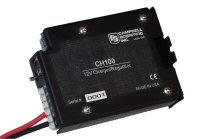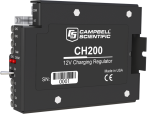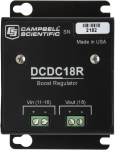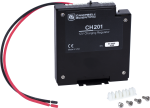This product is not available for new orders. We recommend ordering: CH150.

| Services disponibles |
|---|
Aperçu
Le CH100 est un régulateur de charge pour une batterie rechargeables de12 V. Ce régulateur fournit une fonction de compensation en température pour optimiser les performances de la batterie. Il est couramment utilisé quand une batterie rechargeable est nécessaire pour l'application et que l'alimentation PS100 ou PS12E-LA (7 Ahr) ne permet pas une alimentation suffisante se votre système de mesure.
Lire la suiteImages










Fichiers 3D/CAD :
Description technique
Le CH100 est un régulateur de charge pour une batterie rechargeable de 12 V. Ce régulateur fournit une fonction de compensation en température, pour optimiser les performances de la batterie. Il est couramment utilisé lorsqu'une batterie rechargeable est nécessaire pour l'application ou lorsque l'alimentation PS100 ou PS12E-LA (7 Ahr) ne sont pas suffisantes pour alimenter votre système de mesure.
Le CH100 contrôle le courant circulant à la batterie et empêche le courant de la batterie de s'écouler vers la source de charge.
Compatibilité
Veuillez noter : Ce qui suit montre des informations de compatibilité générales. Ce n'est pas une liste complète de tous les produits compatibles.
Divers
| Produits | Compatibilité | Note |
|---|---|---|
| 34029 |
Informations de compatibilité supplémentaires
Le CH100 est utilisé avec les blocs d'alimentation BP17 et BP24.
Spécifications
| input Voltage (CHG Terminals) | 15 to 28 Vdc or 18 Vac RMS |
| Charge de la tension de sortie | Temperature-compensated float charge (for 12 Vdc battery) |
| Limite du courant de charge | 1.2 A (typical) |
| Tension de sortie (+12 Terminals) | Unregulated 12 Vdc from battery |
| Length of Red and Black Wires | ~30 cm (12 in.) |
| Dimensions | 10.2 x 7.0 x 3.9 cm (4.0 x 2.8 x 1.5 in.) |
| Poids | 158 g (5.5 oz) |
Courant de repos |
|
| Charge Source Present | 3 to 5 mA |
| Sans source de charge | 0 mA |
Documents à télécharger
Brochures
Notes techniques
FAQ
Nombre de FAQ au sujet de(s) CH100: 13
Développer toutRéduire tout
-
No. The CH100 is designed to charge a 12 Vdc battery pack, not a 24 Vdc battery pack.
-
The CH100 has a built-in diode that only allows battery current to flow out of the battery to the 12 V and G terminals. But, because both loads are hooked up to the same battery, the system still drains the same. If there are two loads, and one is of a lesser priority than the other, the lower priority load can be controlled by connecting it to the SW12 on the datalogger and turning it off if the battery voltage starts to get too low.
-
When the current from a solar panel is pushed through long, small-diameter cables, there is a voltage drop generated across the copper cables. This can be minimized by using shorter cables, if possible, or by using cable with a larger diameter (large-gauge wire). Some customers have successfully installed panels up to 50 and 100 ft away.
-
The red LED light on the CH100 or PS100 comes on whenever there is a working charging source connected. For example, if a solar panel is connected to the device, and the sun is shining, the LED light will turn on until the sun starts to go down. The red LED light should always be on when the device is connected to the wall transformer (when the ac power is present). Thus, the LED light is only a confirmation of power available to charge the battery.
If it is desirable to have an indication that the power switch is on, an LED light can be added to an unused control port on the datalogger and a program can be written to cause the LED light to blink every few seconds. Blinking the LED light once every few seconds will not put a large load on the battery, whereas a continuously lit LED draws down the battery more quickly.
-
Not quite. The PS24 consists of a 24 Ah battery, a CH100 regulator, and a 10 by 12 in. environmental enclosure. Aside from the enclosure, the PS24 is very similar to a BP24 combined with a CH100.
-
The BP24 should never be connected directly to an unregulated solar panel. A voltage regulator, such as the CH100, must be included in the circuit, or damage to the battery will occur.
-
No. The CH100 will limit the current coming in from the 30 W panel to approximately 1.2 A, but it should not damage the regulator.
-
With a solar panel connected, the quiescent current should be less than a 3 mA draw on the solar panel to light up the LED. (It does not consume current from the battery.) At night, the blocking diode blocks all measurable current from the battery. For power budget calculations, use 0 mA for the CH100 or PS100.
-
The PS100 (and CH100) are limited to 1.2 A of input. Because the SP20 20 W solar panel generates 1.17 A, that single panel represents a practical limitation to the input. For panels that generate current greater than 1.2 A, consider the PS200, Smart Power Supply and Charge Controller, or CH200, Smart 12 V Charging Regulator, for up to 3 A of input, or pn 18529, 10 A, 12 V, Morningstar Regulator, which is capable of accepting 10 A of input.
Generally, it is not recommended to connect more than one panel at a time. Differential shading can cause issues, such as the shaded panel acting as a current sink.
-
The CH100 Charge Controller is designed to work with maintenance-free deep-cycle lead-acid batteries. The voltage of the charger is slightly different than what is required to charge the marine-type flooded-cell battery. Therefore, Campbell Scientific recommends purchasing a deep-cycle battery, such as the BP12 or BP24, rather than a flooded-cell battery. Note that our regulated solar panels, such as the SP20R and SP10R, are intended to be used with, and connected directly to, a user-supplied flooded battery.
Applications
In 2013, a sinkhole appeared next to a historic home in southern Louisiana. Over the......En savoir plus
Actuellement, les glaciers tropicaux andins sont dans un processus accéléré de fonte. Ces glaciers sont......En savoir plus






